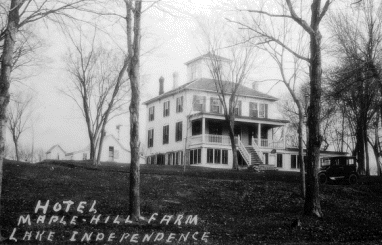The Resort Years (1900-1950)

Postcard dated 1911

Pieper's Farm, dated 1923
Credit: photocopy of photo, photo location unknown, may be Maple Plain Museum

Maple Hill Farm, dated 1923
Credit: Maple Plain Museum

Article in the Minneapolis Journal, July 26, 1902.
Farm Cottages and Fishing Resorts
By the 1900’s Lake Independence had become a popular vacation destination. The lake was already known to sportsmen -- in 1889 a group filed incorporation papers for the "Lake Independence Angling and Hunting Club." In 1902 the Minneapolis Journal had a contest for students to describe their ideal camp location and one of the entries described a campground on Lake Independence. The 10th grade girl who submitted the entry painted a vivid picture of what this area looked like at the beginning of the century (see left).
In the early 1920’s there were three resorts located in Independence Beach – Maple Hill Farm (where Baker Park is now), Broulettes (where Dockside is now) and Pieper’s Farm Resort (across from Lakeshore Park). A fourth resort, Beer’s Resort, was located in Independence on the south shore at Beer's Point. These were not like today's "resorts"; they consisted of a small main building, a few cottages and a fleet of rental fishing boats.
The early resort cottages were very small, usually just a main room and a screened-in porch. In the early years there were no kitchens; guests at Maple Hill and Piepers ate in the main building. Later, basic kitchens were added on, sometimes with a dirt floor. Electricity was installed in 1933.
Lake Independence was very low during the 1930's drought. Some of the resort cottages were located on land that is now under water. The edge of the water was a long walk from the normal shoreline. But the resorts continued operating.
During WWII, Independence Beach was a popular destination for soldiers on leave. The dance hall at Wilson's Resort was a big attraction for young men and women looking for some fun.
By 1950, the cottages were slightly larger, with a main room, bedroom, kitchen and screened-porch. But they were still basic by today’s standards. There was no plumbing; the cottages had outhouses. Drinking water was available from a spring at the foot of Brook Street. Some families brought gallon jugs of water with them from the city.